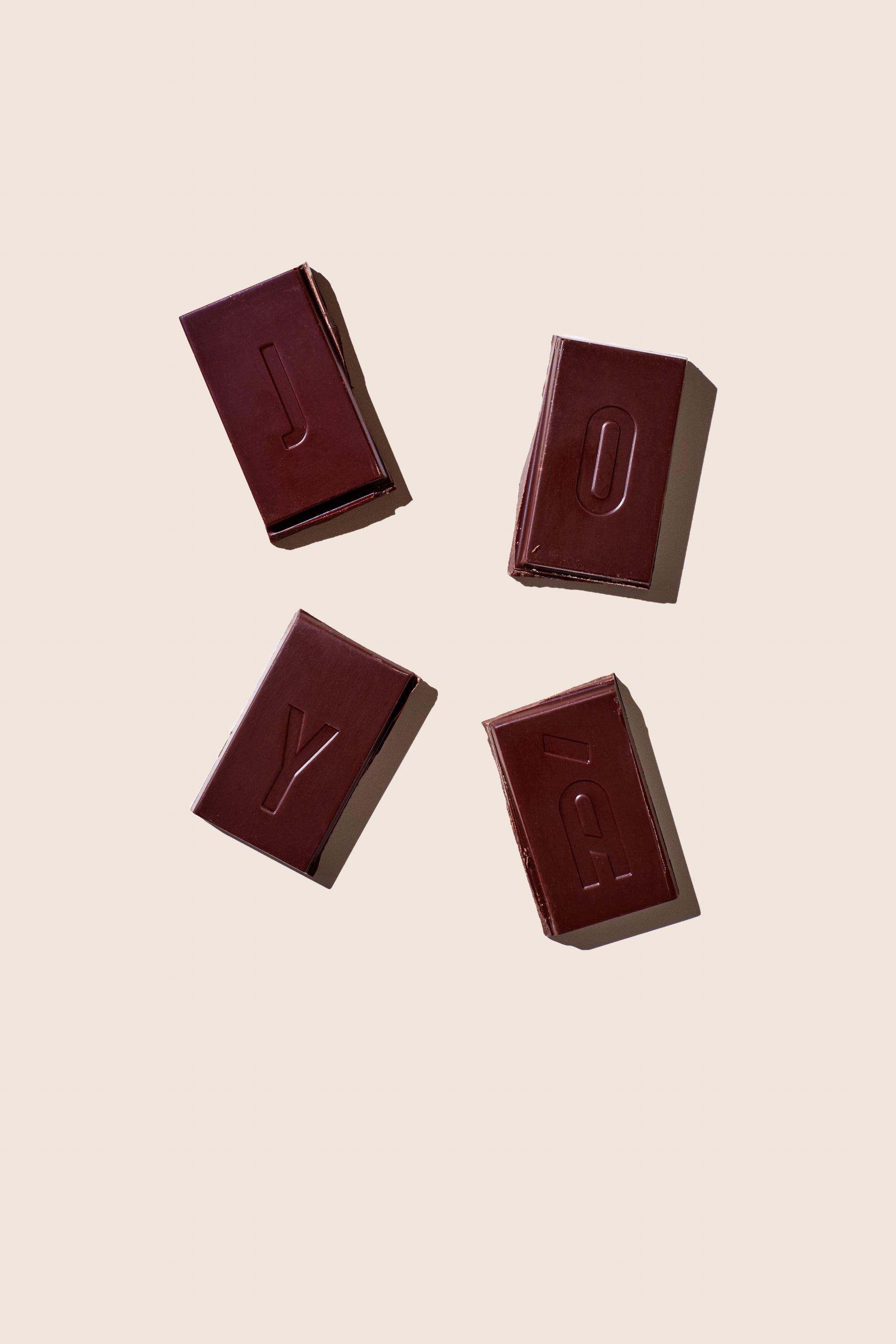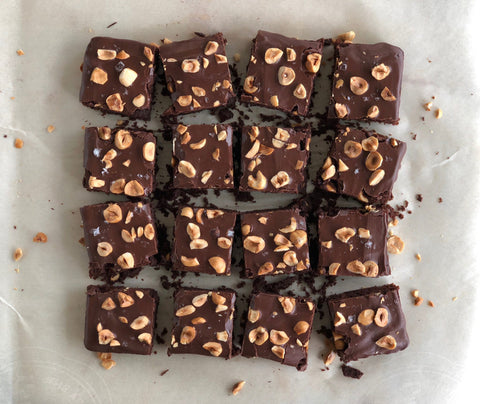
Question: Dear Ruthy, I keep hearing that chocolate “can be” healthy, but how do I know that I’m buying the good stuff and not candy?
Short Answer: Cacao is truly a powerful superfood. As we’ve discussed before, it’s antioxidant rich and a great source of magnesium — a mineral needed for hundreds of biochemical reactions in our bodies and key to muscle and nerve function. Studies also suggest that cocoa flavanols might be associated with improved cognitive function.
But you’re right to be concerned, since not all chocolate is created equal! Most of what you can buy on grocery store shelves has been so overly processed and loaded with refined sugar and preservatives that it’s stripped of any of its goodness. I’ll explain why some chocolate is considered “healthy,” the health benefits of dark chocolate, and give you a few rules of thumb that you can follow to make sure you’re getting the good stuff.
Is Chocolate the New Health Superfood?
Sort of. But before you head to the market to buy as much chocolate ice cream, drizzly chocolate syrup, and decadent chocolate candies as you can consume, it’s important to know exactly what to look for and what the benefits are.
It might surprise you to think of chocolate as an integral part of your wellness plan. How can chocolate impact heart health and insulin resistance, and also potentially lower risks of heart disease? The reason why some chocolate, especially chocolate with high cocoa content, is considered healthy is because of its humble beginnings. Chocolate, whether milk chocolate or dark, begins as a plant.
The cacao tree, native to countries in the Amazon basin area of South America, produces fruit in the form of football shaped pods that are harvested for their contents. Inside each pod is sweet white pulp and juice that covers cacao beans (also called cocoa beans or cacao seeds). The beans are sometimes eaten by themselves (a snack called cacao nibs) or ground into cacao powder, which can be used for other purposes. When cacao powder is processed, much (but not all) of the fat inside the bean (known as cacao butter) is removed.

What Are the Health Benefits of Dark Chocolate?
The reason why dark chocolate is said to have more health benefits than other types of chocolate is because it contains more cacao (ground up cacao beans) than other types. Raw cacao is packed with important nutrients and also offers antioxidant protection, supporting brain health and whole-body health, which is why dietitians and nutritionists alike love dark chocolate.
The benefits of consuming chocolate come from eating the type of chocolate that is closest in composition to the cacao beans from which it was made. Less processing and less heat mean less of the antioxidants (including polyphenols and flavonoids) and nutrients are stripped during the process. (You can read more about the differences between raw, unprocessed cacao and highly processed cocoa here.)
Antioxidants
Plants contain compounds with antioxidant properties called flavanols, which are beneficial to our bodies. This is where it gets a little sticky. Milk chocolate doesn’t contain as many flavanols (read: benefits) as dark chocolate, and white chocolate (which is really just made with cocoa butter solids, sugar, and flavoring) contains next to none.
The flavonoids inside cacao powder offer antioxidant protection that keeps your cells safe from oxidative stress. When we’re exposed to external stressors and toxins like UV rays from the sun, cigarette smoke, pollution, or even toxins in household cleaning solutions, molecules called free radicals are generated in our body. Free radicals are also generated as a by-product of normal metabolism.
Free radicals are unbalanced molecules that can damage healthy cells. The cellular damage can be replicated in new cells upon proliferation. This process can contribute to everything from premature skin aging, to numerous metabolic illnesses, including cardiovascular diseases and type 2 diabetes and various degenerative conditions.
Antioxidants protect cells from free radicals, offering themselves up like tiny little sacrifices so that the free radicals damage them and not your cells. That’s a valiant effort for a little compound found in a dark chocolate bar.
Nutrients
Cacao is nutrient-dense, containing lots of fiber, magnesium, potassium, calcium, and moderate amounts of iron, which can help combat iron deficiency.
Cognitive and Mood Support
Who doesn’t feel better after eating chocolate? While some of the mood-enhancing benefits of chocolate consumption might be anecdotal, the entire experience (from taste to texture) is enough to help elevate mood and help you experience pleasure.
Early studies also show that cacao flavonoids accumulate in the brain, supporting brain health, improving blood flow within blood vessels, promoting nerve growth, and supporting heart-healthy blood pressure levels, making dark chocolate the new brain food on the block.
Choosing Your Chocolate
Knowing the benefits of dark chocolate is a start, but learning how to pick the best, most beneficial dark chocolate is key to getting these benefits. Here are our tips for choosing the best bar.
1. The Higher the Cacao Content, the Better
The percentage cacao content of a bar refers to the total of cacao mass and cacao butter in the bar proportionally to the other ingredients. The higher the cacao content, the lower the sugar.
Ideally, you want to stay above 70% (or you can go lower if the chocolate contains other nutritious ingredients rather than more sugar, such as the coconut and functional herbs in our Dark Chocolate).

2. Look Out for the Sugar Source
A ton of added sugar is common in chocolate, especially if it’s milk chocolate. Dark chocolate bars generally have less sugar than milk chocolate, so you’ll already benefit by choosing dark chocolate instead of milk chocolate.
Of course, you want to consume any type of sugar in moderation, but bars sweetened with unrefined sugars such as coconut sugar are a better bet. For example, coconut sugar contains a small amount of vitamins and minerals as well as inulin (a form of soluble fiber), which helps stimulate the growth of good bacteria in the gut. It also has a lower glycemic index than cane sugar, which helps prevent dramatic spikes and crashes in blood sugar levels.
Alcohol sugars and other sweeteners such as erythritol, xylitol, sucralose and stevia can cause digestive upset for some (not to mention, have a chemical-like taste), so these sweeteners are also something to look out for.

3. Look Out for Weird Ingredients
As with all food we eat, it’s important to pay attention to what’s really in it. Opting for less heavily processed ingredients will decrease the burden on your body.
With chocolate, such ingredients can include soy/soy lecithin and other emulsifiers, gums and even wax! The more unadulterated, the better.
4. Beware of Dairy
While infants can typically digest lactose with no problem, many people begin to develop a reduced ability to digest lactose after infancy. In fact, experts estimate that about 68 percent of the world’s population has lactose malabsorption.
If you know that you're sensitive to dairy, or you've noticed that you suffer from digestive upset (such as bloating, gas, constipation or diarrhea) when you consume dairy products, you're better off sticking with dairy-free chocolate.
5. Consider How the Cacao Beans are Sourced
High-quality cacao is specifically grown, harvested, fermented and dried for its flavor rather than just as a commodity. Responsible growers who use sustainable practices support a healthy ecosystem, and what’s good for the planet is good for us!
If you want to know more about the difference between raw cacao and cocoa, see my earlier discussion on that here.
Chocolate, But Make It Healthy

There’s an easy button for enjoying the benefits of dark chocolate without the stress of choosing the wrong type. JOYÀ sources all of our cacao from ethical, sustainable farms in the Dominican Republic. Our products contain pure cacao that is third-party tested to ensure quality.
Adding it to your daily routine is easy — just grab our Calm Cacao Superblend or any of our functional chocolate bars. You’ll get all the cacao you want, chef-crafted, indulgent flavor, and a blend of complementary herbs and adaptogens to help support your body’s wellness.
So what are you waiting for? Kick back and relax with a steamy cacao Superlatte and a delicious functional chocolate bar to support your body from the inside out.

Sources:
Flavonoids: an overview | PMC
Chocolate Consumption and Risk of Coronary Heart Disease, Stroke, and Diabetes: A Meta-Analysis of Prospective Studies | PMC
Free radicals, antioxidants and functional foods: Impact on human health | PMC
Iron | Health Professional Fact Sheet
Effect of cocoa and theobromine consumption on serum HDL-cholesterol concentrations: a randomized controlled trial | The American Journal of Clinical Nutrition | Oxford Academic
Effects of chocolate on cognitive function and mood: a systematic review | PMC
Coconut Sugar: Chemical Analysis and Nutritional Profile; Health Impacts; Safety and Quality Control; Food Industry Applications | PMC
Cocoa and Chocolate in Human Health and Disease | PMC
Short-term administration of dark chocolate is followed by a significant increase in insulin sensitivity and a decrease in blood pressure in healthy persons | PMC

Ruth Elnekave is a Toronto-based chef, holistic nutritionist, culinary instructor, recovering corporate lawyer and founder of JOYÀ. Her projects are fuelled by one main goal: to spread the pure joy and wellbeing experienced when sharing and savouring delicious, real food.
